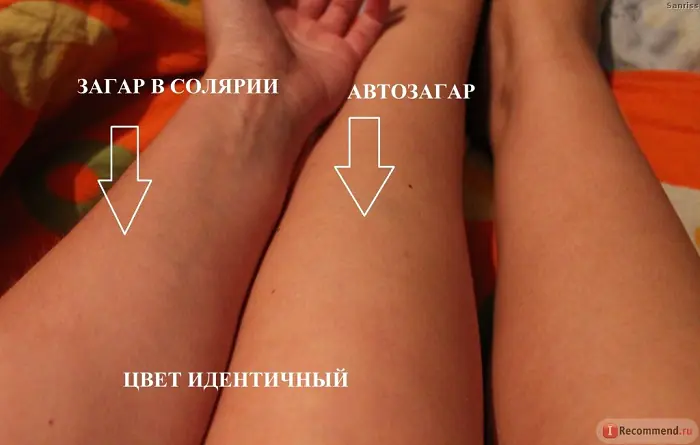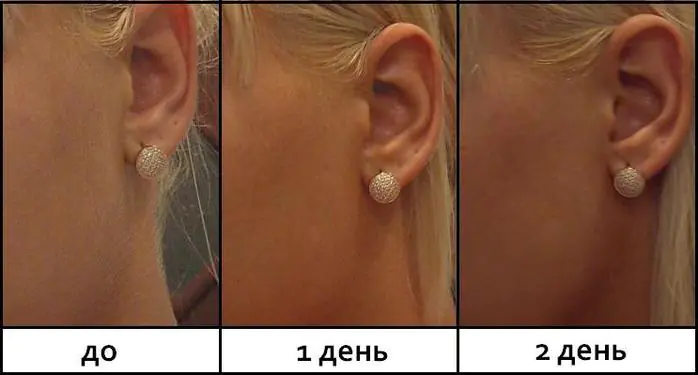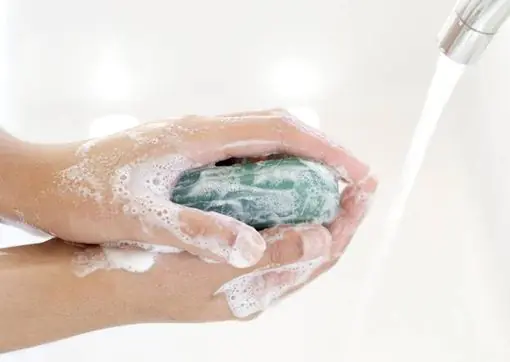When you don’t have time to sunbathe, or it’s winter outside, but you always want to look beautiful, self-tanning will help. It will quickly create the appearance of tanned skin, as if you had just returned from the resort. Self-tanning is a cream, spray or lotion that colors the skin, giving it a tanned tint. Anyone who wants to try this technology on themselves for the first time and knows nothing about self-tanning should read everything written below.
How to choose a self-tanner
The main active component of self-tanning is dihydroxyacetone; it reacts with the upper layers of the skin and forms the desired pigment, which gives the desired color. The higher the concentration of dihydroxyacetone in the self-tanning composition, the more intense the result will be.
To choose a self-tanner, the main thing is to know your skin type. Self-tanning developers take into account all the features and create the optimal product for everyone. And, to facilitate the selection process, we created a classification of self-tanning.
- Light – for blondes and redheads and fair-haired people who have light, thin skin and light eyes. A lot of sun is simply contraindicated for such people. The products in this series will give your skin a natural tan color. Milk and tonic work well, but not wipes or creams with a thick texture.
- Medium – this type is suitable for owners of light brown and brown hair with brown and green eyes. For such people, the sun will not cause harm, unless, of course, you abuse it. But, in any case, there will be no sunburn on such skin. Self-tanning will have a denser texture and a darker shade. It is optimal to use lotion, it will gradually give color to the skin, and you will see for yourself when it is time to stop.
- Dark – for girls with black hair and dark skin. They are not afraid of the sun at all. Sun tan immediately falls on the skin, giving even more shades. These girls need to be careful with self-tanning so as not to turn themselves into an unnatural chocolate bar. Wipes or lotions work well.
How long does it take for self-tanning to appear?
The self-tanning time is written on the packaging. Usually it is 2-6 hours after application. Also, it depends on your skin. After applying self-tanner, you should not take a shower (you will wash off everything you applied) and wear clothes (there will be stains). You need to know that remedies that appear very quickly also disappear quickly.
How long does it last?
Self-tanning only affects the upper layers of the skin, and as cells die and the skin exfoliates, it disappears. Self-tanning lasts on the skin for 5-7 days, for a permanent long-term result, it is worth repeating the application procedure every 2-3 days.
Self-tanning or solarium
There is a lot of debate about which is better - self-tanning or solarium. To determine the answer, you need to consider all aspects of these methods.
Self-tanning dries the skin very much and disappears quickly; it also applies unevenly to the skin and can leave stains on clothes and skin. It does not affect the structure of skin cells and does not penetrate the body. If you don’t like the result of application, you can easily wash it off and repeat the procedure. Self-tanning is convenient to use if you want to have a tanning effect that does not last long and quickly (for example, it is perfect for an evening party). Self-tanning can be applied both at home (this is a little more complicated) and in a specialized salon.
A solarium allows you to get a more even tan that will last longer. It takes at least several days to achieve this effect. Ultraviolet light stimulates the production of vitamin D in the body. Also, ultraviolet rays disrupt the structure and elasticity of the skin. During the procedure, you can get burned because it dries the skin and you cannot control the humidity level. Solariums, ultraviolet radiation in general, provoke the occurrence of cancer and prevent sufficient oxygen from penetrating the skin.
Although the result of a tanning bed is better, the negative factors and risk of serious illnesses indicate that it is better to use self-tanning to achieve a tanning effect.
Is it possible to sunbathe with self-tanner?
Self-tanning only acts on the surface of the skin, coloring it. It has no effect on the penetration of ultraviolet rays, the skin remains vulnerable to sun exposure. If you are going to sunbathe with a self-tanner, be sure to use sunscreen and skin moisturizers, because the skin will dry out even more. The best option would be to wash off the product before sunbathing, because it clogs the skin pores.
Self-tanning is a good way to achieve a beautiful summer sun effect. It is easy to use and easy to wash off if, for some reason, you need to return to your previous skin color. Self-tanning is not harmful to health and can be applied even at home, which gives this method a great advantage. If you want to quickly have beautiful, tanned skin, try self-tanning and you will love it.
Experts say that you can sunbathe after self-tanning. Pre-application of instant bronzer has its advantages:
- On the beach it will not be noticeable that the person came to relax for the first time.
- If the skin burns a little, the consequences (redness) will not be so noticeable.
- Sun tan goes well with reed tan. The top layers will already have a tint, so the color will gradually wash off. But ultraviolet radiation affects the lower layers, thereby slowly replacing self-tanning. Usually this happens unnoticed. As a result, only the natural shade remains, and the transition occurs smoothly and gradually.
The tan is applied to the self-tanner even a little faster and easier. The shade becomes more saturated. However, after a while, the tan color will become a little paler as the artificial one washes off. The cream additionally moisturizes and nourishes the skin, making it firmer and more elastic, so you can avoid flaking, itching and fatigue.
To avoid the “leopard” effect, you should choose a high-quality auto bronzer from a well-known brand.
It is worth remembering that products for an instant golden hue do not contain protective radiation barriersUVB/UVA. Therefore, tanning after self-tanning can more strongly contribute to aging and pigmentation; self-tanning agents do not protect against burning and damage from ultraviolet rays. They have no filters.
The skin acquires a bronze tan due to the reaction of the dyes in the product with proteins in the stratum corneum. And because of the dark shade, the sun is attracted more strongly. Therefore, before going out, you should apply a cream with a high level of sun protection that does not allow UVB/UVA rays to pass through.
Self-tanning does not interfere with getting a beautiful shade in a solarium. The skin turns golden due to exposure to ultraviolet radiation and the production of melanin in the dermis layers. Thus, the principle of tanning is exactly the same as when sunbathing.
Many people don’t even realize that products for obtaining a bronze tint in a solarium already contain auto-bronzants.. Therefore, the tan turns out more intense and much faster. To maintain it, you can periodically apply a layer of auto-bronzant to the skin. This will eliminate the risk of the pigment being washed out in spots.
Self-tanning safety precautions:
- Self-tanning should be applied to dry and clean skin. After showering, you should wait about half an hour.
- Scrubbing and epilation must be done in advance so as not to damage the epidermis layer.
- Apply the product in a thin, even layer using a special mitten. You need to move from bottom to top in a circular motion. Pre-moisturize the skin.
- You need to let the bronzer dry and absorb. Then, even without a natural one, stains and stains will not appear.
- It is better to increase the intensity gradually.
- After a couple of days, you need to do scrubbing and peeling to renew the layer of the epidermis, and the new tan will lay down evenly.
- You should sunbathe during safe hours, that is, in the morning and after lunch.
- Apply a thick layer of sun protection before going to the beach and renew it periodically.
Read more in our article about tanning after self-tanning.
Read in this article
Does the tan go away after self-tanning?
A light golden tint to the skin gives it radiance, freshness and a healthy appearance. In addition, it helps hide some imperfections. The traditional way to get a bronzed skin tone is by sunbathing. But many people don’t want to go to the beach with a pale body, so they use special products that turn their skin golden.
However, after using them, many people may have questions about how the tan lasts after self-tanning. Some are afraid that it will wash off with stains. Uneven care of self-tanning will ruin the appearance and reveal that it is artificial.
But experts say that you can sunbathe after self-tanning. Nothing wrong with that. In addition, the use of instant bronzer has its advantages:
- On the beach it will not be noticeable that the person came to relax for the first time.
- Even if the skin burns a little, the consequences, that is, redness, will not be so noticeable.
- Sun tan goes well with reed tan. The top layers will already have a tint, so the color will gradually wash off. But ultraviolet radiation affects the lower layers, thereby slowly replacing self-tanning. Usually this happens unnoticed. As a result, only the natural shade remains. Therefore, the transition occurs smoothly and gradually.
The self-tanner applies a tan without any problems. It even grabs a little faster and easier. The shade becomes more saturated. However, you should be prepared for the fact that after a while the tan color will become a little paler, because the artificial one is washed off. Moreover, the cream additionally moisturizes and nourishes the skin, making it firmer and more elastic. Therefore, by regularly applying it, you can avoid peeling, itching and fatigue.
Those who have tried tanning with an artificial shade share different experiences. For some, the color went on evenly, and the instant auto-bronzant washed off. The transition happened unnoticeably. Others say that after leaving the artificial auto-bronzant, stains appeared. The shade did not apply evenly. No one can predict exactly how it will turn out in a particular case. To avoid the “leopard” effect, you should choose a high-quality auto bronzer from a well-known brand.
And here is more information about why self-tanning spots.
Is it possible to sunbathe in the sun?
As mentioned above, the skin still tans through self-tanning. But it is worth remembering that products for an instant golden hue do not contain protective barriers against UVB/UVA radiation. Therefore, tanning after self-tanning may contribute more to aging and pigmentation.
You must be extremely careful with artificial tint, since auto bronzers do not protect against burning and damage from ultraviolet rays. They have no filters. The skin acquires a bronze tan due to the reaction of the dyes in the product with proteins in the stratum corneum. But it does not become a natural barrier against UV rays the way melanin does. Moreover, due to the dark shade, the sun is attracted more strongly. The skin becomes more vulnerable.
Therefore, every time before going out, you should apply a cream with a high level of sun protection. An SPF 30+ filter is considered a reliable barrier. Also, the cream should not allow UVB/UVA rays to pass through.
Does the skin tan in a solarium after self-tanning?
Self-tanning does not interfere with getting a beautiful shade in a solarium. The skin turns golden due to exposure to ultraviolet radiation and the production of melanin in the dermis layers. Thus, the principle of tanning is exactly the same as when sunbathing.
Moreover, many people do not even realize that products for obtaining a bronze tint already contain auto-bronzants in their composition. Therefore, after a solarium, the tan turns out more intense and much faster.
Modern auto-bronzants contain nourishing and moisturizing components. Therefore, when used, the skin retains a healthy and well-groomed appearance.
To maintain a beautiful tan, you can periodically apply a layer of auto-bronzing agent to your skin. This will eliminate the risk of the pigment being washed out in spots.
Therefore, the answer from experts to the question of whether it is possible to sunbathe in a solarium after self-tanning is positive. It is important to choose high-quality products that will give the desired shade and care for the epidermis.
Security measures
To ensure that the tan goes on evenly and does not wash off in spots, it is necessary to correctly use products with auto-bronzing agents. The following recommendations will help avoid the leopard effect:
- Self-tanning should be applied to dry and clean skin. After showering, you should wait about half an hour.
- Scrubbing and epilation must be done in advance so as not to damage the epidermis layer.
- Apply the product in a thin, even layer using a special mitten. You need to move from bottom to top in a circular motion. You should moisturize your skin first so that the self-tanner goes on evenly.
- It is necessary to allow the bronzer to dry and absorb and begin to work. Then, even without a natural one, stains and stains will not appear.
- It is better to increase the intensity gradually.
- After a couple of days, you need to do scrubbing and peeling to renew the layer of the epidermis, and the new tan will lay down evenly.
- You should sunbathe during safe hours, that is, in the morning and after lunch.
- Apply a thick layer of sun protection before going to the beach and renew it periodically.
Read more about self-tanning for legs here.
Self-tanning does not interfere with tanning under the sun or in a solarium. In order not to get an unexpected “leopard” effect, you need to apply the cream carefully, following all the rules. As a result, self-tanning can make the shade more intense, and you can get it much faster.
Useful video
Watch the video on how to tan in one day:
You can choose a self-tanner for your legs taking into account certain rules - the desired tone, the characteristics of the product. It is important to figure out in advance how to apply it correctly and how to quickly wipe it off or wash it off if something goes wrong. Which is the best self-tanner for your legs?
Striving for a beautiful tan, you have to study what is better - a solarium or self-tanning. Each of them has its own advantages and disadvantages, but the most important thing is to know which is more harmful to the skin.
Many people are sure that self-tanning is harmful to both the skin of the face and body. However, manufacturers have long included mainly useful components in their composition. And they are still better than direct sunlight. To reduce the number of side effects, it is important to understand how to use self-tanning.
You need to choose a self-tanner for your face taking into account your existing problems and phototype. For fake tan to look its best, it needs to be applied correctly. What kind of self-tanner can you use on your face?
Understanding the reasons why self-tanning appears on your body can be difficult. Sometimes it depends on the application, sometimes on the product itself. Why did the appearance of pigment spots also begin? What is a good self tanner for the body?
| In contact with: | |
| Facebook: | |
| Classmates: |  |

Photo from the site: sovetclub.ru
Traditionally, we sincerely sympathize with everyone who is stuck in dusty and hot cities in the summer. After all, this is the time for hiking, bivouacs in nature, gentle sea waves splashing near the shore and persistent rays of sunshine, inexorably making our skin darker and our thoughts happier. However, such a pleasure as a beautiful natural tan is not available to every beauty who wants to look attractive, well-groomed, and fashionable at all costs, because business can keep us in the city, but work does not allow us to go to the beach and lie around to our heart's content. scorching rays.
If previously you could only shrug your shoulders and sit in a stuffy office, covering your white legs with the hem of a sundress, now you can use one of the many self-tanning products that the market offers in a fairly wide range, and become sporty, tanned, as if you had just come from the gentle sea. However, in view of recent conversations about the safety of cosmetics, I would like to find out whether self-tanning is harmful to the skin, are we making things worse for ourselves by lubricating the dermis with a composition about which we know absolutely nothing? This is exactly what we will find out today, answering numerous questions from lovers of chocolate skin tones.
Simple solutions to complex problems: how self-tanning works

Photo from the site: irecommend.ru
Contrary to the most controversial opinions that can be heard from consumers, all creams, sprays, gels and other cosmetics that can give the skin a rich and tanned color actually contain the same substance called dihydroxyacetone. It is this chemical compound that “knows how” to react with the upper layers of the epidermis, after which it acquires a distinct brownish, bronze, and sometimes reddish tint.
The higher the dihydroxyacetone content in a self-tanning cream, gel or even spray, the richer, darker and thicker your skin tone will be. Thus, you should not buy a product with a high content of this substance if your skin has a milky white tint, since coloring it right away will not be easy, and may even be impossible. It is better to get a product with a cumulative effect that acts gradually.
Since we are going to understand it thoroughly, it is worth knowing that the upper layers of the skin do not oxidize when applying any self-tanning product, but a different reaction occurs, which scientists call the Moyar reaction. In fact, the substance contained in the cream simply reacts with sugars and amino acids, which become darker as a result.
It is interesting that the shade of your own skin will not depend at all on the chosen product, which is worth remembering, but on the characteristics, composition, as well as other qualities of the dermis. The entire interaction reaction occurs in the upper layers of the epidermis, and we can say that self-tanning creams have absolutely nothing to do with ultraviolet radiation and the reaction it causes, and there cannot be anything in common.
How to use the sun in a bottle: self-tanning - application is simple, ridiculously so

Photo from the site: imolodost.com
Each self-tanning product, that is, for giving your own skin a beautiful tan, must have its own instructions for use, which accurately describe the entire process and must be clearly studied before applying a cosmetic product to your body. Moreover, it doesn’t matter at all whether you decide to apply self-tanning after a solarium to add brightness to the shade, or just because. True, in addition to individual instructions, there are also general recommendations that should not be ignored at all, but on the contrary, need to be taken into account.
- Whenever you apply any kind of self-tanner to your body, it should be completely clean. It is unacceptable to smear your skin with such a product just after coming from the beach, for example.
- You should definitely make an exfoliating mask or a whole body scrub. This will help get rid of possible stains, streaks and streaks.
- Gel, cream, jelly or spray should be applied no earlier than ten minutes after visiting the bath or shower, since the pores must close. Otherwise, you risk turning into a speckled person.
- Try to spread the product evenly over the entire surface of the skin, as excess of it can also lead to the appearance of unsightly spots.
Be sure to do the test, the instructions for which are slightly below, in order to protect yourself from a possible allergic reaction, because if you get a rash, then the next question, whether self-tanning works for tanning, will no longer be relevant at all.
Time H: how long does it take for self-tanning to appear?
Another fundamental question that interests quite a few of our subscribers, especially those who cannot be patient or read the instructions for this or that product. Moreover, whatever one may say, the time when a new dark shade will appear is definitely written on the packaging or in the accompanying documentation (instructions) and you only need to spend two minutes of your own precious time to read it.

Photo from the site: liveinternet.ru
Most often, such remedies appear within two hours, and sometimes it can take up to a quarter of a day. If we are talking about cumulative self-tanning, then the first time you may not notice anything at all, since it acts gently and gradually. Moreover, it is worth remembering that the faster the cream acts, the easier and easier it will most likely be washed off. You need to know that almost all self-tanners stain clothes, so first dry thoroughly and only then put on your clothes.
How long does self-tanning last on the body: calculate the following procedure
There is another fundamental question that also worries many women extremely much, and it sounds like this: how long does self-tanning last, and how long will it take before it completely disappears. It is quite difficult to answer this seemingly simple question in general terms, because in many ways it is very individual and depends on the characteristics of your own body.

Photo from the site: anukapohudei.ru
As has already been repeated, pigment from a cosmetic product qualitatively colors only the very top layers of the epidermis, without penetrating deep into it. This means that as the cells of this epidermis die and exfoliate, the tan will gradually fade, in fact, be washed away. Most often this happens within seven or nine days, but it can happen earlier. But if you want to maintain an even, uniform color, then it is better to constantly repeat the procedure, at least two or even three times a week.
Is it possible to sunbathe with self-tanner in the sun: summer is calling
So, from everything that has been said above, it becomes completely clear whether it is possible to sunbathe after self-tanning, and the answer is quite positive. These cosmetics simply paint the top layer of skin, which, by the way, will be washed off over time, along with the dye, and does not trigger any further processes in the human body, hence its complete harmlessness. Of course, provided that you do not have an individual, personal intolerance to the components of the product.

Photo from website: intensa.pro
This means that it is quite possible to go out into the sun and sunbathe while smearing yourself with a self-tanner, and it will not affect your natural tan at all if it does not contain special filter particles. Among other things, it can help you tan because it attracts more ultraviolet radiation, but it can dry out the skin, also for this very reason. So it’s worth going and sunbathing, even if you have an excellent self-tanning cream, just stock up on special cosmetics that you usually use and everything will be very good.
Original high-quality self-tanning: harmful or not
The excitement that has recently arisen around original tanning products, which are conveniently and beautifully lined up on the shelves of our cosmetic stores, was not caused by chance. Cosmetologists and doctors around the world unanimously insist that bronzers, gels, sprays, and creams simply cannot bring any harm, because, as already mentioned, they have nothing to do with ultraviolet radiation, and, consequently, with photoaging. However, you can put yourself in danger even by purchasing the treasured tube, which seems so harmless and harmless.
- Any self-tanning can cause harm if you bought a low-quality product of unknown origin. You shouldn’t take such cosmetics from unverified retail outlets, from stalls on the market, and even more so from shady characters in underground passages or gateways, otherwise it’s no wonder you’ll get a terrible allergic reaction.
- Many people, out of ignorance, think that if they applied self-tanning to their body, then the rays of the sun are no longer afraid of them, but everything is exactly the opposite. Darker skin attracts ultraviolet radiation more strongly and will burn much more easily. If you want this to not happen, you should buy only those products that contain special filters.
- With regular use, for example, daily or even three times a week, slight dehydration of the skin may occur, which, however, can be easily corrected with other cosmetic moisturizing creams and other products offered on the market today.

Photo from the site: sun-planet.ru
Among other things, it is also worth considering that self-tanning products are usually certified, so feel free to ask for such papers in the store. If they are in no hurry to present them to you, it is better to pass by to avoid consequences. That is, in fact, this product is completely harmless, but the question remains whether it is possible to use self-tanning during pregnancy, because mothers do not want to harm their own baby. However, this needs to be discussed separately, as it is an extremely important factor.
Ideal self-tanning: contraindications worth considering
You need to know that there are, of course, contraindications that will prevent you from using self-tanners. There are few of them and basically, this is the personal predisposition of the body. Otherwise, such products are completely harmless, especially high-quality, branded ones, which you only need to buy in a store.
- Vitiligo, psoriasis and other chronic skin problems.
- Cuts, scratches, punctures and other mechanical damage.
- Inflammatory processes on the surface of the epidermis, acne, rashes, pimples.
- Oncological diseases of the dermis.
Is it possible to use self-tanning during pregnancy: the health of babies comes first

Photo from the site: o-krasote.com
It often happens that just during the summer period you really want and dream of looking bold, daring, tanned and beautiful; there comes a time when a little life is born inside and it would be a crime on our part to harm it. In fact, it is not recommended for mothers expecting offspring to spend a long time in the sun. Therefore, an unusual number of women are really sincerely interested in whether pregnant women can use self-tanning, whether it will harm the baby and what consequences may arise. We will try to answer these and other questions.
To begin with, it is worth recalling that all the reactions that color our skin with a golden or chocolate hue under the influence of the product occur in the upper layers, and these substances are not able to penetrate into the deeper layers. However, there is still something to worry about; self-tanning for pregnant women can be harmful if it contains substances that can cause allergies. Therefore, you should definitely closely monitor the composition, and it wouldn’t hurt to test the product before spreading it all over your body.
In order to make sure that you definitely do not have an allergy to this cosmetic product, it is worth doing a simple test. To do this, apply a little product to the cleansed skin of the inside of the wrist or elbow and leave for several hours. There is no need to worry that a speck will remain; it can be easily removed with a slice of lemon. If after twelve hours there is no redness, itching or other unpleasant things, then everything is in order and the product can be used.
And again about babies: self-tanning while breastfeeding
There is another extremely important question: is it worth using such bronzers and self-tanners while breastfeeding, as well as in general during lactation. That is, you need to find out whether self-tanning cream is harmful for a child and how its application can affect his health. The question here is quite complex, and it concerns no longer the child, but the mother herself.
First of all, you need to listen to the opinion of professional doctors, as well as cosmetologists, who unanimously declare that no self-tanners acting on the surface of the epidermis can harm either the mother, the baby, or during pregnancy, as we have already said, neither while breastfeeding.

Photo from the site: woman.ru
- However, there are nuances, for example, the product that you purchase, by definition, must be of high quality and not a fake. Such options cause allergies, and this is not suitable for us.
- Try not to lubricate the nipples with cream, which will end up in the baby’s mouth in a minute or two. This will not lead to anything good, so you should apply the product carefully so that it never gets into the child’s body.
- Due to hormonal spots, which most often appear in pregnant women in the most unexpected places, and then can go away not just for months, but also for years, the result of applying a self-tanning cream or spray is almost completely impossible to predict. So if you don’t want to turn into an elderly Dalmatian or Burenka the cow, you should be careful.
In addition, mothers are interested in whether it is possible to sunbathe with a self-tanner and whether it will harm the baby. There will definitely be no harm, and the skin tans in the same way as without the product applied to it, provided that it does not contain UV protective filters.



